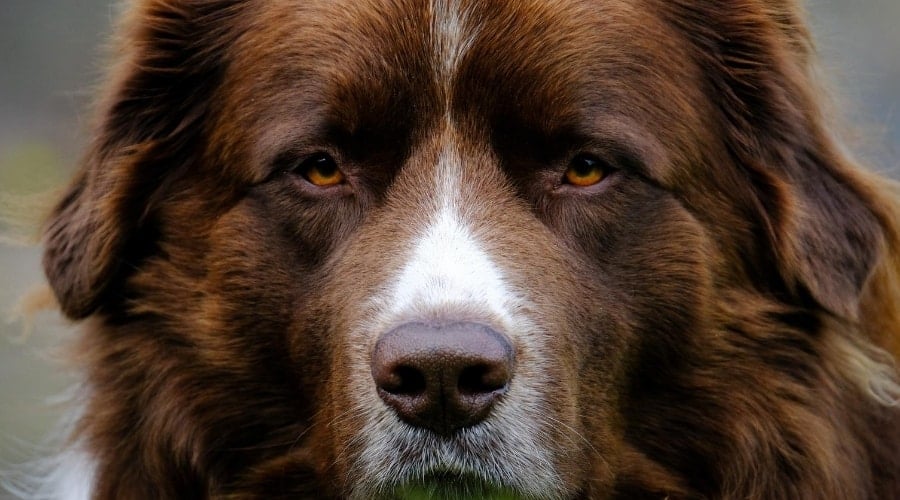Irish Setter Mixes: 10 Different Cross Breeds You’ll Love
When you purchase through links on our site, we may earn a commission. Here’s how it works.
The Irish Setter is a stunning and unusual breed. With their distinctive, wavy red coat and elegant movement, the breed certainly makes a beautiful addition to any family. Irish Setters are members of the gundog group. These are wonderful family dogs, making great playmates for kids and sweet-tempered companions for everyone. The Irish Setter excels in the hunting field and loves to take part in canine competitions, too, including agility and rally.
Table of Contents
The Irish Setter’s gorgeous, rich mahogany coat is highly prized, and that, together with the breed’s kind, willing nature, makes them a natural candidate for mixed breeding. In this article, we’ve tracked down ten of the most popular Irish Setter mixes that you’ll find around today, as well as some of the more unusual ones.
We’ve provided you with all the information you need to enable you to decide if one of these good-looking, friendly dogs would make a perfect family pup for you. So, what makes the perfect mixed-breed dog?
F1 Irish Setters
When it comes to mixed breeds, or designer dogs as they are sometimes called, you should know that these are not just random crossbreeds. A mixed-breed dog is actually a well-bred pup with parents who are both purebred. That’s what makes an “F1 crossbreed.” F1 crossbreed dogs have precisely half of each parent dog’s genes.
However, that doesn’t necessarily mean that the puppies will inherit equal portions of both their parent’s characteristics. Although the intention of mixed breeding is to harvest the best bits from both parent dogs, it doesn’t always work out like that.
The same applies to the puppy’s health, too. Although good crossbreeding can screen out the most serious health conditions of the parents, some issues may remain that could be passed on to the puppies. That’s especially true of parent breeds who share the same health problems.
No Irish Setter mixes are recognized by the American Kennel Club. However, you will find most crossbreeds registered with one of these organizations that are dedicated to the mixed breed:
You can trace your pup’s parents through these registries and make sure that your furbaby has no temperamental or health issues that you need to know about.
Irish Setter Mixed Breeds
So, now you know all about F1 mixed breed dogs, here’s the lowdown on Irish Setter mixes. First of all, what’s the best dog to cross with an Irish Setter? When considering which Irish Setter mix to opt for, it’s important to remember that all crossbreeds carry genes from both parents. So, you can never be sure just which of his parents your puppy will take after the most.
That’s one of the things that makes taking on a mixed breed so exciting. Before you part with any cash for an Irish Setter mix puppy, be sure to ask the breeder to show you proof that both the pup’s parents have been health-screened. Let’s take a look at our 10 favorite Irish Setter mixed breeds.
Golden Irish: Golden Retriever Irish Setter Mix

The Golden Irish is a cross between an Irish Setter and a Golden Retriever. This beauty makes a great family dog. These pups love to be around people, playing, and generally being at the center of activity in the home.
The Golden Irish is wonderful with kids and is very loyal and affectionate, too. This mixed breed is smart and trainable, but these dogs do need lots of exercise every day. One long walk and some playtimes will keep your pup happy. Early socialization and sympathetic training are key to making sure that your Golden Irish gets along well with family members, including kids and other dogs.
The Golden Irish is a large dog, so you will need a spacious home with a yard or garden if you choose one of these pups. These dogs typically weigh between 60 and 70 pounds, standing up to 26 inches tall at the shoulder. Your puppy will most likely have a dark golden to red coat with feathering on his legs. Because the coat is long and silky, there’s a danger that it could become matted, so you will need to groom your Golden Irish every day.
The Golden Irish has a lifespan of up to 12 years. Unfortunately, this breed can be prone to a number of health conditions, including hypothyroidism, eye problems, bloat, Von Willebrand’s Disease, hip and elbow dysplasia, and panosteitis. These conditions are commonly inherited from the Golden Retriever parent breed.
Irish Afghan Setter: Irish Setter Afghan Hound Mix
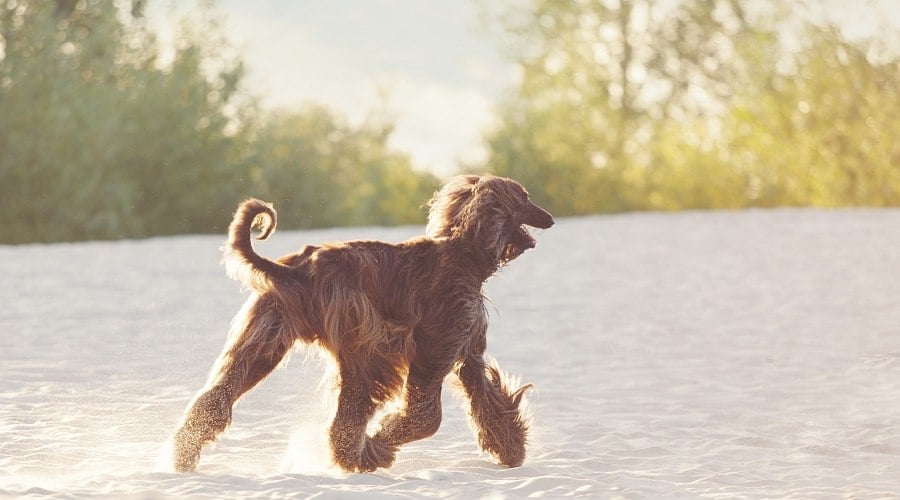
This pup stands an impressive 24 inches tall at the shoulder and weighs roughly between 40 and 80 pounds. These are elegant, graceful dogs that usually have a long, flowing coat in a range of colors, including two-tone. As they are constant shedders, you’ll need to groom your dog on a twice-weekly basis to keep his coat in good condition and free from mats and tangles.
The Irish Setter Afghan Hound mix makes an enjoyable companion and working dog if you’re into hunting, acting as a pointer, and holding birds for his owner too. The crossbreed also loves to take part in canine sports, including rally and agility.
These dogs aren’t barkers or howlers. Although the breed is a very efficient guard dog, these pups aren’t typically aggressive. That said, early socialization and regular training sessions are recommended.
Irish Bostetter: Irish Setter Boston Terrier Mix

The Irish Bostetter is another Boston Terrier mixed breed that’s created by crossing an Irish Setter and a Boston Terrier. These pups are sweet-natured, playful, intelligent pets that enjoy spending time with their human family. These dogs are active, needing plenty of exercise every day to keep them physically and mentally stimulated and content.
The Irish Bostetter is a medium-sized dog, growing to be between 19 and 22 inches tall and weighing up to 45 pounds. In appearance, the breed is typically less gangly and is stouter in build than the Irish Setter. The Irish Setter and Boston Terrier cross is a relatively low-maintenance crossbreed that sheds moderately all year round, requiring regular brushing to remove loose and dead hair.
This crossbreed has a life expectancy of around 12 years and is generally healthy. However, there are a few health conditions that your Irish Bostetter may suffer from, including patellar luxation, bloat, cherry eye, hip dysplasia, and Progressive Retinal Atrophy (PRA).
One downside to the Irish Bostetter is that they can be very sensitive to their surroundings, and that can lead to barking, which could be an issue for you if you have close neighbors.
Irish Cocker: Irish Setter Cocker Spaniel Mix

The Irish Setter Cocker Spaniel mix is a medium-sized dog, reaching around 22 inches in height and weighing up to 40 pounds. The size will usually be split between the two parent breeds, but this mix can be smaller if it takes after the Cocker Spaniel parent. This crossbreed is very family-oriented and loves to spend time with adults, kids, and other pets too.
These dogs love to take part in canine sports, especially agility and rally, in which they excel. This mixed breed has a medium-length coat that sheds moderately, requiring a brush once or twice a week to keep hair loss to a minimum. The coat color varies from golden brown to sandy blonde. The Irish Setter Cocker Spaniel mix is a healthy dog with a lifespan of up to 12 years. However, one health condition that can affect the breed is hip dysplasia.
Irish Dachshund: Irish Setter Dachshund Mix
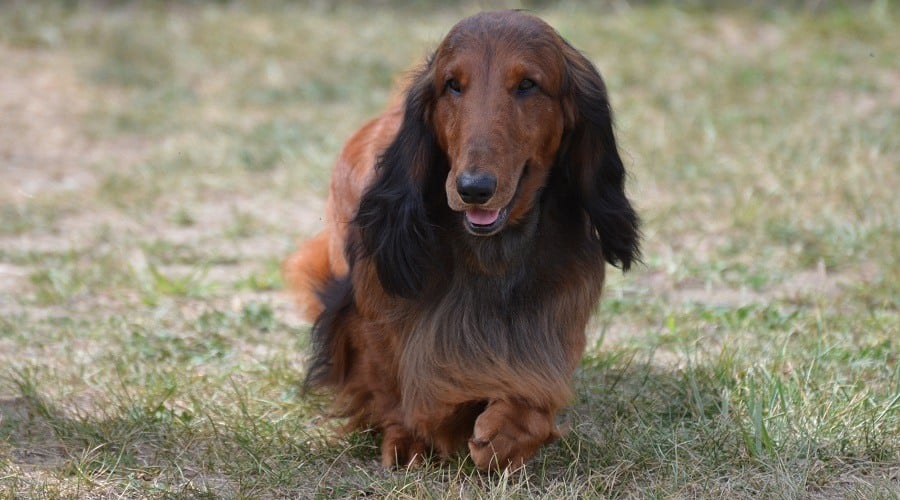
The Irish Dachshund is a medium-sized dog that can weigh up to as much as 30 pounds. The Irish Setter Dachshund mix does need a fair amount of daily exercise, including a long walk and playtimes, too, as obesity can be a problem for these dogs. Obesity tends to come from the Dachshund parent, as they can be lazier as they age.
Also, you’ll need plenty of time to groom your Irish Setter Dachshund mix, as the breed does tend to shed a lot all year round. When it comes to home and family life, the crossbreed is usually good with kids and other pets and enjoys spending time with his human family.
This crossbreed is quite long-lived and can have a lifespan of up to 13 or 14 years. Although they are usually pretty healthy, Irish Setter Dachshund mixes can be susceptible to hip and elbow dysplasia.
Irish Doodle: Irish Setter Poodle Mix
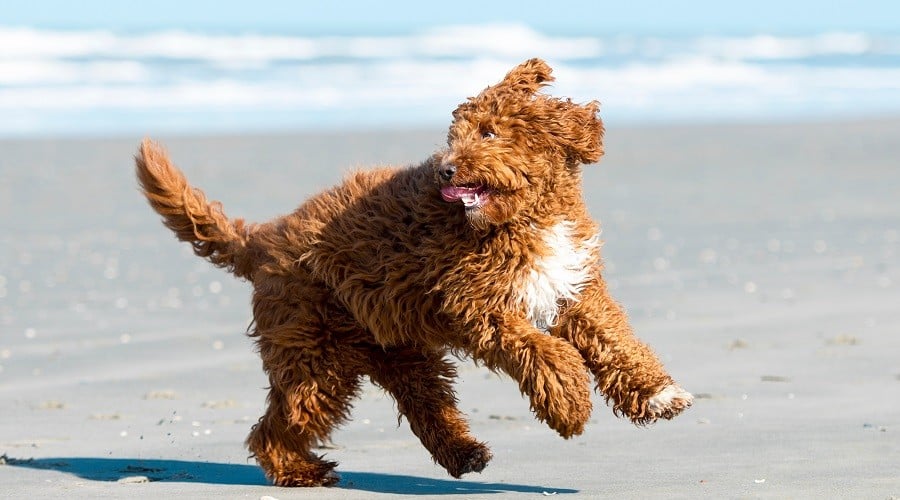
These dogs vary in size, depending on the variety of Poodle (toy, miniature, or standard) that the Irish Setter is mixed with. For example, an Irish Setter crossed with a Mini Poodle will probably be between 15 and 25 inches tall and weigh from 20 to 35 pounds. However, a standard Irish Doodle will be slightly taller and heavier.
Both Irish Setters and Poodles can be prone to hip dysplasia and eye problems, although these are generally healthy dogs with a life expectancy of up to 13 years. Also, like the Irish Setter, the Poodle has long ears that flop over the dog’s ear canals. That can predispose both of these breeds to ear infections.
Irish Setters have a long, silky coat that needs brushing at least every other day to keep it free from tangles and mats. The Poodle’s coat is short, very curly, and does not shed. However, if not groomed regularly, the fur can become matted.
So, if you take on an Irish Doodle, you’ll need to be prepared to groom your pet regularly, at least every other day. The Irish Doodle is smart and friendly, although the Irish Setter can be prone to nervousness and may be destructive if left unoccupied for long periods. The Irish Doodle is willing and keen to please, although they do have boundless energy and need plenty of exercise. Both parent dogs have high prey drives, so an Irish Setter Poodle mix might not be the best choice if you have vulnerable family pets, including rabbits and cats.
Irish Rottie: Irish Setter Rottweiler Mix
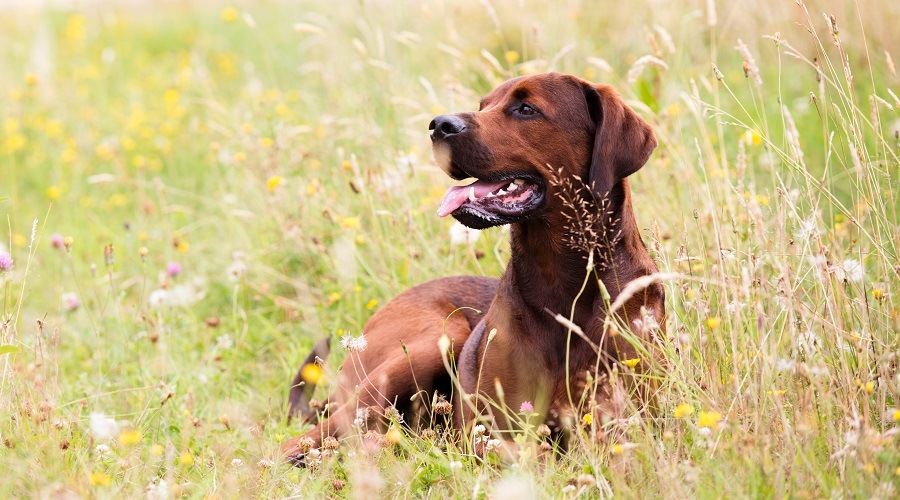
These are energetic dogs that can be a good choice for an active family that loves to spend time outside. The Irish Setter Rottweiler crossbreed makes great guard dogs because of their Rottie heritage and is very protective of their human family, but they can be a little suspicious of strangers who visit your home.
Although the breed is trainable, you will need to make sure that your dog is well-socialized from puppyhood to make sure that his protective nature doesn’t cause problems with aggression in the future. The Irish Setter Rottweiler mix is a large dog, standing between 19 and 27 inches tall at the shoulder and weighing in at between 40 and 130 pounds, depending on which parent the puppy takes after. So, you’ll need a large house with lots of outside space to comfortably accommodate one of these lively pups.
This breed needs plenty of mental stimulation, as well as lots of exercise, to keep him happy. Irish Setter Rottweiler mixes can be susceptible to separation anxiety, so be sure to provide your dog with plenty of toys to keep him busy if he’s left home alone.
Irish Setter Great Dane Mix
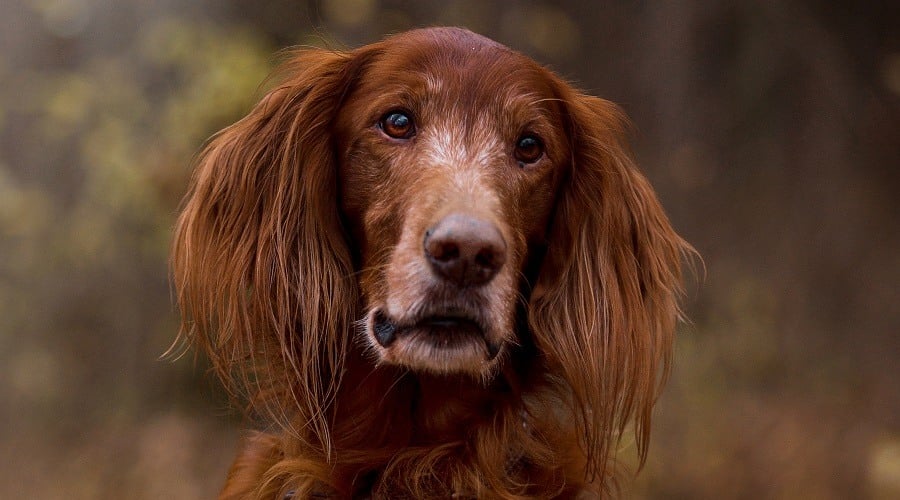
As you would expect, these dogs are large and can stand up to 27 inches at the shoulder, depending on which parent the puppies take after. So, you will need a large home with plenty of outside space to accommodate one of these unusual mixed-breed pups.
Although lively and playful, the Irish Setter Great Dane mix gets along really well with other dogs and kids, making this a wonderful choice for a family pet. Sweet-natured and always eager to please, the Irish Setter Great Dane mixed breed loves to be around his human family and doesn’t do well if left alone for long periods when he can suffer from separation anxiety.
Like many large dogs, the Irish Setter Great Dane mix does not have a very long life expectancy, typically surviving for around ten to 12 years. Although mostly healthy, the breed can be susceptible to elbow and hip dysplasia.
Irish Shepherd: Irish Setter German Shepherd Mix
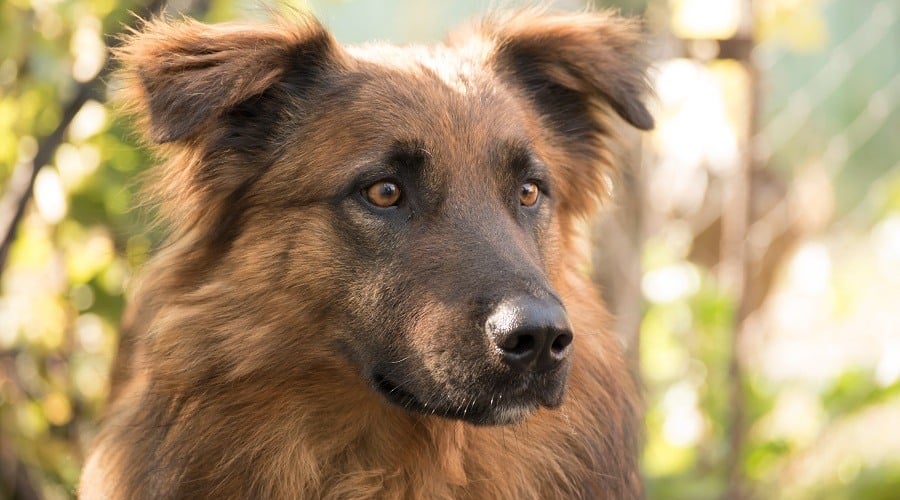
These are large dogs that are not suited to apartment living and will be happiest in a large home with a fenced backyard or garden. The GSD parent breed is usually not one that will do well without a lot of activity.
The Irish Shepherd stands between 26 and 28 inches tall, weighing from 65 to 90 pounds. Although generally healthy, Irish Shepherds can be vulnerable to heart disorders, osteosarcoma, and bloat. These dogs usually live to be around 13 years of age.
Irish Shepherds usually have a double coat, molting continually year-round and having two heavy shedding periods seasonally in the spring and fall. For that reason, you’ll need to brush your dog several times a week and daily when the coat is shedding most heavily.
When it comes to temperament, the Irish Shepherd can be serious, or he can play the clown, depending on which parent the puppy takes after the most. These dogs are usually friendly towards kids, although they can be a little too rambunctious for tiny children and toddlers.
The Irish Setter German Shepherd mix can be very protective of his family, although they generally get along well with other dogs, provided they are well-socialized and trained as puppies. These are very lively dogs who need plenty of daily exercise. This crossbreed makes the ideal jogging companion and will joyfully take on canine sports, including rally, tracking, and agility.
Lab Setter: Labrador Retriever Irish Setter Mix

The Lab Setter is a large dog, standing up to 27 inches tall at the shoulder and weighing around 60 to 70 pounds. So, you’ll need a large house with plenty of outside space to accommodate one of these pups.
Lab Setters are playful and energetic, and they do need lots of physical exercise every day. They get a lot of their energy from the Lab parentage, but Setters are also known to be active. This breed makes a great family dog, as they’re usually good with kids and other pets too.
These dogs are pretty trainable, but they do benefit from early socialization and training from day one. Bear in mind that if your Lab Setter doesn’t receive enough mental and physical stimulation, he will get bored, and that could lead to destructive behavior.
The Lab Setter is a moderate shedder, so a twice-weekly brushing should keep your dog looking tidy and keep his skin in good condition. While you’re grooming your dog, be sure to clean his floppy ears to prevent wax buildup and keep the risk of infection to a minimum. The Lab Setter is generally a healthy breed, although they can suffer from hip dysplasia, bloat, and Progressive Retinal Atrophy (PRA).
Final Thoughts
The purebred Irish Setter is one of the dog world’s comedians with a sweet, endearing nature that makes this sporting breed a popular choice of canine companion for those who enjoy an outdoorsy lifestyle.
The Irish Setter’s lively nature and working pedigree must be borne in mind when you’re choosing a crossbreed that has one of these lovely dogs as a parent. Some of these mixed breeds do need lots of exercise every day to keep them fit and healthy, so don’t take on an Irish Setter mix if you don’t enjoy walking and spending time outside.
The Irish Setter is a confirmed family favorite, getting on well in a home that has kids, other family pets, and families of all sizes. So, depending on the other half of the mixed breed, you can be confident that your Irish Setter mix will make a wonderful family pet.

